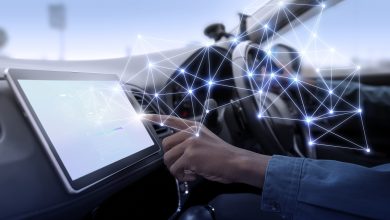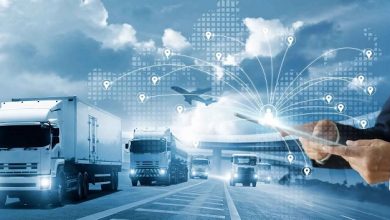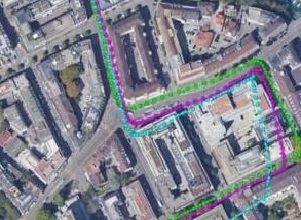Challenges & Converging Technologies in Logistics & Transport

The distance from digital to physical is shrinking day by day. The world is getting more connected. The world is virtually moving towards becoming a global village in most of the facets of human needs and transactions. Due to exponential developments in travel and communication, sharing of scientific and technological developments has revolutionized not only how we live and interact but has conjoined the world economies. Sharing of surplus goods, services and resources from one habitat to another in a state or in a nation and lastly but not the least among the world nations is the core of this global village, thanks to continuously developing means of transportation and travel.
The canvas of movement of goods and people is dotted with the number of mobility options. The prominent ones being shipping, railways, aeroplanes, and now drones, air taxis are slowly joining the fray. But, goods transportation and passenger mobility by road is still the most utilized option in world economy and same goes for India too.
According to Mordor Intelligence report, Transportation Industry in India – Analysis of Growth, Trends and Forecast (2020 – 2025), transportation industry contributed roughly 6.3% of GDP and is majorly dominated by road sector. Whereas in many developed economies, transportation accounts for between 6% and 12% of the GDP. In addition, logistics costs can range between 6% and 25% of GDP. The government has recognized the seriousness of the development of this segment for the economic health of the nation and has allowed 100% FDI in roads and highways sector to boost connectivity across the country.
Where does the problem lie?
There are several challenges in India’s logistics sector that are contributing in high logistics cost such as no uniformity in state policies, slow pace of digital adoption, poor transport infrastructure, under-developed road network and many more. Different components of logistics sector such as production, warehousing, transportation, wholesale, and retailing are affected by these and various other problems.
High logistics cost in India in comparison to other countries is an area of concern as it creates challenges for the manufacturing growth and comprehensive development of the country. According to a report by Arthur D Little and the Confederation of India Industry (CII), India’s Logistics and supply chain costs currently amount to a staggering US$400 billion, up to 14% of the GDP, China’s 9% and the US and Europe on average at 8%. If we compare it to the global average of 8%, India’s logistic cost has raised a competitiveness gap of approximately US$ 180 billion.
With the increasing number of vehicles on the road, the management of transport and fleets becomes a critical component in the gamut of supply chain. The future of transportation and logistics lies in technology and digital innovations. Traditional ways of managing operations and flow of required information are becoming obsolete, inefficient and costly. That’s where telematics based software solutions come in.
Twin Software solutions
The two most important software being utilized in logistics and transport segment are fleet management (FMS) and transport management software (TMS). The difference between a TMS and an FMS is that TMS solves planning, execution and post-processing (mostly day-to-day ops processes), while FMS focuses solely on fleet telematics and providing visibility on the movement of vehicles.
In the transportation and logistics industry, FMS and TMS are prominent for their contribution in managing the operations in an efficient, transparent and online sharing of information with all stakeholders. Both these software are having most of the common features, but their focuses are different and they are not mutually exclusive, but are used in combination by large fleets’ operations. However, for logistics companies FMS is more suitable while in case of organizations having transport focus TMS is more in use.
Fleet Management
The world is marching into the era of connectivity with instantaneous online sharing of information, adopting more effective methods of driver-vehicle communications and vehicle-to-infrastructure connectivity. To manage all the problems occurred in managing fleets we have come a long way from the time when fleet management solutions were only a means for tracking vehicles. More and more comprehensive software solutions are reaching the market with newer and better features in line with the rising expectations of stake holders in logistics. Some of the important Indian and global companies in fleet management are given below (Table 1 & Table 2):
FMS Solutions providers in India (Table 1)
| Sl No | Company | Solution | Head Office |
| 1 | Arya Omnitalk | Fleet Vigil | Pune |
| 2 | Autoplant | En Route | Maharashtra |
| 3 | BlackBuck | Blackbuck – Trucker | Bengaluru |
| 4 | Bosch India | iTraMS | Bengaluru |
| 5 | CarIQ (Varroc) | CarIQ Platform | Maharashtra |
| 6 | Intellicar (TVS) | TRACK | Bengaluru |
| 7 | SmartDrive (Omnitracs) | Omnitracs One | Hyderabad |
| 8 | iTriangle | aQuiLa Track | Bengaluru |
| 9 | Axestrack | Swift | Rajasthan |
| 10 | Jungleworks | Tookan | Haryana |
| 11 | MAK Tree solutions Pvt. Ltd | MAKTree | Bengaluru |
| 12 | Kale Logistics Solutions Pvt. Ltd | HELIOS | Delhi |
| 13 | Here Technologies | HERE Last Mile | Bangalore |
| 14 | LOZICS | LOZICS | Mumbai |
| 15 | Scania | Scania Fleet | Karnataka |
| 16 | Roundtrip | EasyRoutes | Tamil Nadu |
| 17 | SparkMinda | TrackITplus | Pune |
| 18 | Uffizio | Trakzee | Gujarat |
| 19 | Odoo | Odoo Fleet | Gujarat |
| 20 | Traxoid Automations | Traxroot- Fleet | Bengaluru |
FMS Solutions providers (International Companies Table 2)
| Sl No | Company | Solution | Head Office |
| 1 | Mireo | MireoFleet | Balkans |
| 2 | Fleetio | Fleetio | UK |
| 3 | Geotab | MyGeotab | Canada |
| 4 | Track Your Truck | NetTrack | Lynchburg, US |
| 5 | Onfleet | Onfleet | USA |
| 6 | Avrios International | Avrios | Germany |
| 7 | GPS Trackit | GPS Trackit | USA |
| 8 | Heavy Vehicle Inspection & Maintenance | Heavy Vehicle Inspection Maintenance Fuel HVI APP | USA |
| 9 | Verizon Connect | Verizon Connect | USA |
| 10 | GPS Insight | GPS Insight | USA |
| 11 | Teletrac Navman | TN360 | Australia |
| 12 | Abivin | Abivin vRoute | Singapore |
| 13 | Route4Me | Route4Me | USA |
| 14 | Whip Around | Whip Around | USA |
| 15 | Quickbase | Quickbase | USA |
| 16 | Samsara | Samsara | USA |
| 17 | Navotar | Navotar | USA |
| 18 | Gurtam | Fleetrun | Lithuania (EU) |
| 19 | PeopleNet Communications | PeopleNet Fleet Manager | USA |
Converging Technologies in Fleet management
Telematics touches almost every area of fleet management and, therefore, brings a whole addition of use cases to fleet managers. Let’s see how this combination of telecommunications and informatics is pushing the envelope for effective fleet management. Pre historic track and tell telematics devices have long evolved in smart devices playing ubiquitous role in monitoring a vehicle using GNSS, dashboard cams, sensors, and various other tools and technologies. It is used to record and map the vehicle’s location, its route, speed, and ensure the safety of the drivers and passengers through various numerous sensors. It combines telecommunication, vehicle technologies, for instance, road safety, computer science, and electrical engineering to give a connected driving experience.
Real-time updates: With the help of telematics, keeping real-time updates become very easy. With smartly managed fleets, the managers are a lot more flexible in their day to day operations and the business could get more profitable. They can monitor the current status of the vehicles and update the customers with accurate timelines for the delivery of products. Immediate monitoring invites better response to external factors such as inclement weather conditions, temporary disruptions and modified orders.
Safer fleets: Fleet vehicles are equipped with a number of sensors to ensure that drivers on the road follow safe practices. Access to tons of data has been provided regarding diver behavior and vehicle condition. FMS can warn drivers about aggressive activities they may be doing, a vehicle they may collide with while parking, punctured tires, equipment failure, and more
Reduced fuel costs: A NACFE (North American Council for Freight Efficiency) report states that fuel accounts for 22% of the total fleet management cost. And with fuel prices rising, the share is expected to only get bigger. FMS provides detailed reports on fuel consumption and idling of vehicles. With proper evaluation, some instances of unnecessary fuel consumption can be quickly identified and eliminated. Another way that FMS reduces fuel costs is by ensuring optimum vehicle performance.
Predictive maintenance: Vehicles are the most valuable assets. Conventional methods of estimating vehicle maintenance rely either on the number of miles the vehicle has seen or on hours/days of use are already being replaced by the analytical data provided by OBD port in the vehicles. With FMS, vehicle can even signals when vehicle is likely to face some breakdown or actually need maintenance. This helps improve both the life and performance of these carriers. Additionally, predictive maintenance reduces the avoidable cost of breakdown and untimely maintenance. It adds to user confidence in the vehicle reliability.
Cheaper insurance: This has a tremendous potential when it comes to fleet management benefits. Auto insurers now offer the option of usage-based insurance (UBI), which relies on information obtained from telematics black boxes. Reliable-driving behavior builds confidence among insurers that they are less likely to encounter a situation that demands compensation on their behalf. UBI programs have recently become quite popular in many countries and fleet owners there from various businesses are cutting costs with cheap auto insurance – sometimes even as cheap as 40% with Optimum Driving Score. In India too experiment in UBI are being attempted but as yet it is far from securing a worthwhile place in insurance space alongside traditional insurance models.
Internet of Vehicles(IoV). When it comes to fleet management system, Internet of Things (IoT) morphing itself into to IoV. Notepads have been replaced by tablets and handheld devices. The maintenance staff can now quickly scan any part of the vehicle and easily update the Central Hub’s diagnostic report in a matter of seconds. With faster ground operations, fleet manager can easily dispatch vehicles and meet growing demands without losing the edge on the quality side of things. Though IoV has a potential of changing the future of fleet management, yet a lot of developments in policies, business practices will have to evolve before IoV becomes a commercial reality
Connected mobility. is yet another invaluable addition to the fleet management It has brought greater safety and efficiency to the transport models. We are moving to a future where vehicles can communicate with each other to avoid collision, with traffic lights for continuous movement or the infrastructure that communicates with trucks helps them find safe parking spaces.
Big Data and its Impact- Courtesy AI & ML: Fleet management operation consists of multiple data points, and how that data makes the process more efficient. A modern connected vehicle can generate huge amount of data per day of operations could be as high as more than a terabyte in an hour. Yet collecting large amounts of data would be pointless without a powerful way to process it – enter big data! Inspired by Artificial Intelligence and Machine Learning, Big Data aces it with advanced solutions for fleet management.
Augmented Operations with Augmented Reality: Augmented Reality(AR) is still in its nascent stage. But it’s expected to be more relevant in the future of fleet management. From loading the vehicle to driving it safely on the road, AR finds application virtually in almost every aspect of fleet management.AR is a step further with wearable technology. Imagine maintenance workers wearing smart glasses, which let them know just by looking at a selected part of the vehicle. This makes routine inspections easy, reliable. In warehousing operations too observers can easily know the location of each item in the cargo hold, and where to go inside the truck for easy unloading.
Blockchain brings Transparency and Accountability : Blockchain is a method of record keeping where irrevocable records of transactions are available to all participants – making it virtually impossible to alter or fudge the records. Even though blockchain faces some challenges such as standardization in record-keeping methods and acceptance of the technology from various industries, most experts agree that it will play a key role in fleet-management solutions. Blockchain is useful to create transparent, automated payment systems. This makes the transaction part easy for the business well as other parties such as vendors, suppliers, owners and fleet managers. This can be done by creating smart contracts that automatically initiate transactions upon completion of the delivery. Blockchain also removes unnecessary middlemen and third parties from the equation, adding to the overall efficiency of the process.
Ecosystem in India
There are various factors that also need to be addressed for matching world standard in our logistics and transport system.
Low education levels and Lack of Training: Fleet driving is not an easy task. The driver is on the steering for extended periods of time ensuring safe driving standards with the precious cargo behind him. In India, the truck drivers are generally not adequately educated and trained. The survey done by Save Life Foundation in 2020 found that based on educational qualification, overall 37.1% of truck drivers were educated up to primary level (until Class 5th), 44% were educated up to high school level (until Class 10th) while 8.8% were illiterate. Trained drivers take a comprehensive view of what is happening on the road, thus improving the overall safety and efficiency of the operation.
Lack of standards: Indian trucking industry is suffering due to its unorganized nature. Every state has its own different policies. The working conditions for the truck drivers are not satisfactory due to lack of proper standards and regulations. There is no formal association to protect the interests of drivers and this has led to a decline in the number of new players entering the field.
Fragmented Market : As per NITI Aayog report, 2021, around 75 percent of the market is run by small owner-operators who own up to five trucks. Only 10 percent of the market is run by big fleet operators who own more than 20 trucks. Small players are unable to optimize driving patterns and have less ability to invest in larger trucks, digital tools and software, and the expertise required to operate them. This market structure creates an impediment in shift to FMS by these players.
Autonomous Vehicles fleet a paradigm shift
Would a discussion in fleet management be complete without bringing up autonomous vehicles? Obviously not!
Autonomous vehicles are now getting attention in the entire transportation industry, whether it is a taxi booking service or paratransit dispatch system. The benefits of an autonomous vehicle are obvious, especially for commercial fleets. Autonomous vehicles will change fleet management, they don’t need long breaks, are safer on the road, and help cut down costs. Fleets of self-driving vehicles are the next big thing in the future of fleet management.

Conclusion
FMS is an effective innovation for the trucking industry, which is bringing transparency and improves the efficiency of operations for operators, but at present in Indian logistics and transport ecosystem, FMS has a long way to go. In order to make better ecosystem in India, the government needs to take initiatives to improve poor road infrastructure, digital connectivity and develop training centers for training of drivers.
Author:

Richa Tyagi
Editorial Team Member
Telematics Wire
Published in Telematics Wire




